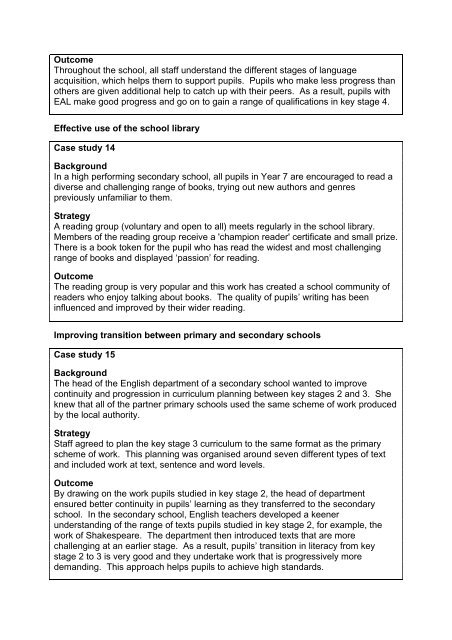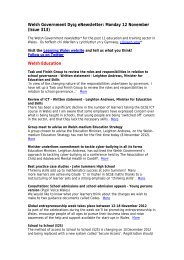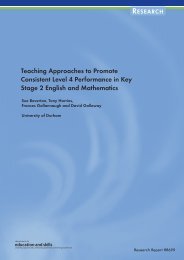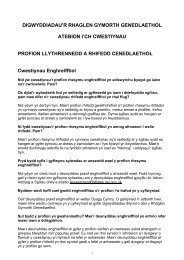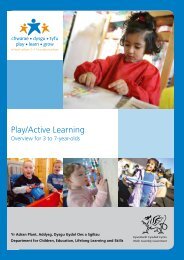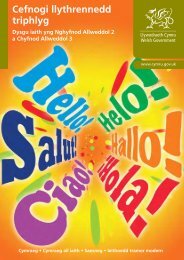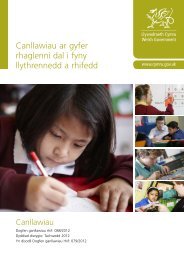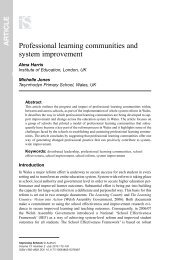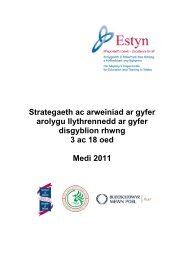Best practice in the reading and writing of pupils aged 7 to 14 ... - Estyn
Best practice in the reading and writing of pupils aged 7 to 14 ... - Estyn
Best practice in the reading and writing of pupils aged 7 to 14 ... - Estyn
Create successful ePaper yourself
Turn your PDF publications into a flip-book with our unique Google optimized e-Paper software.
OutcomeThroughout <strong>the</strong> school, all staff underst<strong>and</strong> <strong>the</strong> different stages <strong>of</strong> languageacquisition, which helps <strong>the</strong>m <strong>to</strong> support <strong>pupils</strong>. Pupils who make less progress thano<strong>the</strong>rs are given additional help <strong>to</strong> catch up with <strong>the</strong>ir peers. As a result, <strong>pupils</strong> withEAL make good progress <strong>and</strong> go on <strong>to</strong> ga<strong>in</strong> a range <strong>of</strong> qualifications <strong>in</strong> key stage 4.Effective use <strong>of</strong> <strong>the</strong> school libraryCase study <strong>14</strong>BackgroundIn a high perform<strong>in</strong>g secondary school, all <strong>pupils</strong> <strong>in</strong> Year 7 are encour<strong>aged</strong> <strong>to</strong> read adiverse <strong>and</strong> challeng<strong>in</strong>g range <strong>of</strong> books, try<strong>in</strong>g out new authors <strong>and</strong> genrespreviously unfamiliar <strong>to</strong> <strong>the</strong>m.StrategyA read<strong>in</strong>g group (voluntary <strong>and</strong> open <strong>to</strong> all) meets regularly <strong>in</strong> <strong>the</strong> school library.Members <strong>of</strong> <strong>the</strong> read<strong>in</strong>g group receive a 'champion reader' certificate <strong>and</strong> small prize.There is a book <strong>to</strong>ken for <strong>the</strong> pupil who has read <strong>the</strong> widest <strong>and</strong> most challeng<strong>in</strong>grange <strong>of</strong> books <strong>and</strong> displayed ‘passion’ for read<strong>in</strong>g.OutcomeThe read<strong>in</strong>g group is very popular <strong>and</strong> this work has created a school community <strong>of</strong>readers who enjoy talk<strong>in</strong>g about books. The quality <strong>of</strong> <strong>pupils</strong>’ writ<strong>in</strong>g has been<strong>in</strong>fluenced <strong>and</strong> improved by <strong>the</strong>ir wider read<strong>in</strong>g.Improv<strong>in</strong>g transition between primary <strong>and</strong> secondary schoolsCase study 15BackgroundThe head <strong>of</strong> <strong>the</strong> English department <strong>of</strong> a secondary school wanted <strong>to</strong> improvecont<strong>in</strong>uity <strong>and</strong> progression <strong>in</strong> curriculum plann<strong>in</strong>g between key stages 2 <strong>and</strong> 3. Sheknew that all <strong>of</strong> <strong>the</strong> partner primary schools used <strong>the</strong> same scheme <strong>of</strong> work producedby <strong>the</strong> local authority.StrategyStaff agreed <strong>to</strong> plan <strong>the</strong> key stage 3 curriculum <strong>to</strong> <strong>the</strong> same format as <strong>the</strong> primaryscheme <strong>of</strong> work. This plann<strong>in</strong>g was organised around seven different types <strong>of</strong> text<strong>and</strong> <strong>in</strong>cluded work at text, sentence <strong>and</strong> word levels.OutcomeBy draw<strong>in</strong>g on <strong>the</strong> work <strong>pupils</strong> studied <strong>in</strong> key stage 2, <strong>the</strong> head <strong>of</strong> departmentensured better cont<strong>in</strong>uity <strong>in</strong> <strong>pupils</strong>’ learn<strong>in</strong>g as <strong>the</strong>y transferred <strong>to</strong> <strong>the</strong> secondaryschool. In <strong>the</strong> secondary school, English teachers developed a keenerunderst<strong>and</strong><strong>in</strong>g <strong>of</strong> <strong>the</strong> range <strong>of</strong> texts <strong>pupils</strong> studied <strong>in</strong> key stage 2, for example, <strong>the</strong>work <strong>of</strong> Shakespeare. The department <strong>the</strong>n <strong>in</strong>troduced texts that are morechalleng<strong>in</strong>g at an earlier stage. As a result, <strong>pupils</strong>’ transition <strong>in</strong> literacy from keystage 2 <strong>to</strong> 3 is very good <strong>and</strong> <strong>the</strong>y undertake work that is progressively moredem<strong>and</strong><strong>in</strong>g. This approach helps <strong>pupils</strong> <strong>to</strong> achieve high st<strong>and</strong>ards.


